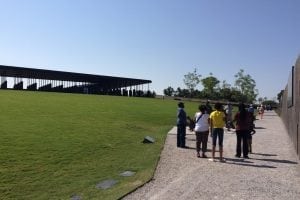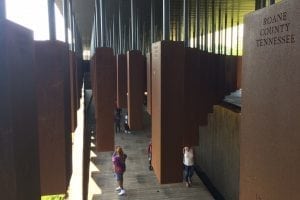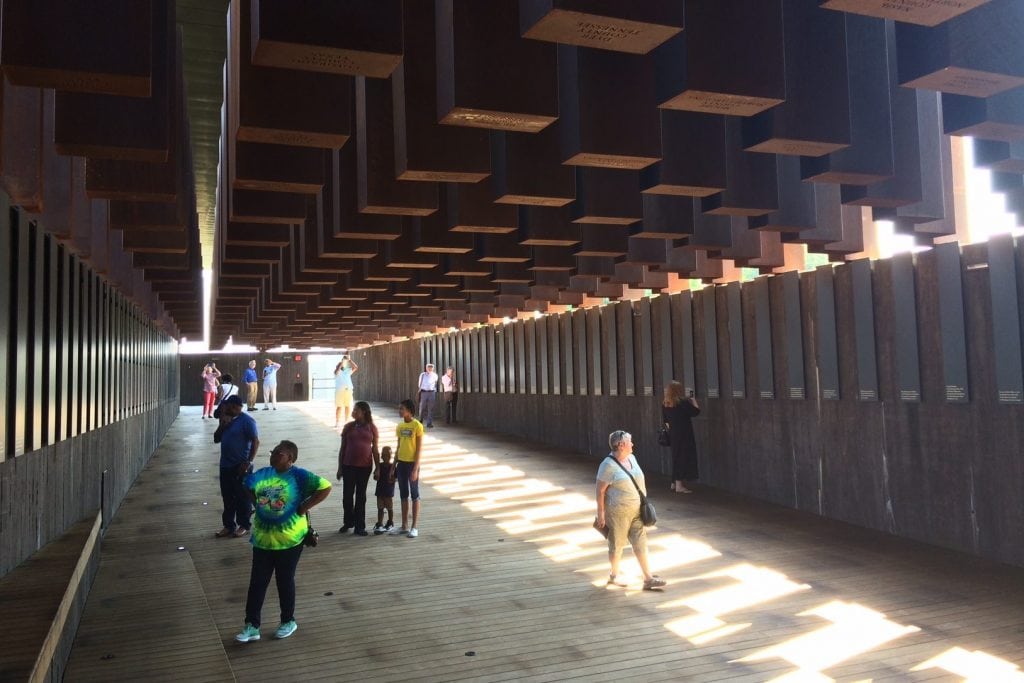Skift Take
In Montgomery, Alabama, the tourism board and a new memorial to victims of lynching are building off each other's visibility, drawing visitors into a revitalized area of the Deep South they may not recognize.
In Montgomery, Alabama, the Equal Justice Initiative’s memorial and museum honoring the victims of lynching — the first undertaking of its kind — is the newest crucial addition to Deep South tourism and black heritage tourism alike.
Despite that EJI’s National Memorial for Peace and Justice (and its accompanying Legacy Museum) confront a harrowing topic from which many people recoil, EJI and the Montgomery Convention and Visitor Bureau are successfully feeding off one another. The former collects rave reviews as a groundbreaking attraction that forces the South to confront its ugly history, and the latter rides a wave of recognition as an up-and-coming destination.
EJI is bringing varied tourists to Montgomery, but also has specific implications for the black travel movement. As the movement flourishes on Instagram, the content leans heavily international, often including heritage trips to Africa. But as history marches on, some black Americans also want to connect with the Deep South, and not just on an exhaustive tour of old statues.
Three months after its April opening, EJI’s memorial receives up to 1,000 visitors on a weekend day and up to 500 on a weekday, according to its box office, and total visitation has topped 100,000, according to EJI Senior Attorney Sia Sanneh. The museum requires timed tickets in order to prevent overcrowding, while the open, outdoor design of the memorial allows for more concurrent visitors.
New Civil Rights Attractions at a Glance
Two years ago, the National Museum of African American History and Culture opened in Washington, D.C. to rave reviews, so popular it continues using a timed ticket system in which free passes get booked up three months ahead. The “Blacksonian” arguably set a gold standard for new cultural museums in the U.S.
High praise for the new civil rights museum in Mississippi came next. The U.S. then inaugurated its first National Civil Rights Trail in January, followed by the 50th anniversary of Dr. Martin Luther King Jr.’s assassination, honored this year in Memphis.
The site of King’s death, the Lorraine Motel, is now the National Civil Rights Museum, which underwent a $27.5 million renovation in 2013 and 2014. Other civil rights museums in the south have also opened or undergone significant renovations in the last five years or so.
Ever since six million black Americans fled the violent Jim Crow South during the Great Migration between the 1910s and 1970s, families have been making trips back to the South to see family, educate younger generations, and pay homage to civil rights sites. Today, according to the census, the four cities with the largest black populations are all in the north: New York, Chicago, Philadelphia, and Detroit.
The EJI Experience Can Dominate a Trip
EJI’s memorial and museum offer an arresting, attention-grabbing, immersive, photographic, educational experience that’s hard to come by elsewhere. A visitor can easily spend five hours at both combined (just shy of the famously long average dwell time at the Blacksonian), knocking other attractions down on the priority list.

EJI visitors ascend a hill at the beginning of the memorial on July 28, 2018, photo by Sarah Enelow-Snyder.
The memorial and museum opened in April to glowing reviews, backed by a massive research report in which EJI chronicled over 4,400 lynchings throughout the South. EJI’s mission lies outside of travel — its founder and executive director, Bryan Stevenson, created the nonprofit legal and civil rights group in large part to get innocent people off death row.
The memorial sits atop a grassy hill overlooking downtown, and features eerily hanging, person-sized, oxidized steel columns that represent the 4,400-plus victims. Each has a companion piece meant to return to the site of the lynching. A docent said many counties have pledged to take their pieces, but none have actually taken them yet, as legislative approval may take some time.
Jacksonville, Florida, may soon be among the cooperative locations. The city is discussing claiming its piece of the memorial and incorporating it into a new downtown monument in a public park.
Many memorial attendees were searching for specific columns, if not specific names. I myself found a family name on the column for Yazoo County, Mississippi, where my maternal family resided for decades. Docents were trained to help people find their family members, which would be difficult without assistance.

EJI visitors stand beneath columns reading victims’ names on July 28, 2018, photo by Sarah Enelow-Snyder.
Local resistance to the project remains — some in the community are resentful about EJI “stirring up” this damning era of history, according to Jim Yeaman, owner of The Lattice Inn in Montgomery. Yeaman said that some unimpressed locals asked, “What do you do after you read the names?” to which Yeaman responded, “Get on your knees and pray for forgiveness for our predecessors who caused this atrocity.”
Visitors enter the memorial at the bottom of a hill, reading plaques with history that is both brief and written for those unfamiliar with the topic. At the top of the hill begins a giant shaded spiral of hanging columns. As the visitor descends, the columns hang further off the ground, allowing visitors to stand beneath them and metaphorically feel their weight. Toward the bottom, a waterfall represents unidentified victims, and in a bed of soil collected from lynching sites, a tiny green plant sprouted spontaneously — without any water, according to a docent.
While the memorial is theoretically wheelchair accessible, pathways are covered in gravel and make navigation difficult.
The museum, a 15-minute walk from the memorial, begins by covering slavery and Jim Crow, which many other museums do just as well — its real strength is the topic of mass incarceration, which few institutions focus on. The museum feels more traditional than the memorial, but still immersive, with memorable video interviews with currently and formerly incarcerated people.
EJI’s interactive map personalizes the experience for many visitors, allowing them to look up individual lynchings. The organization also just released a map of confederate monuments, highlighting a hot topic: the dichotomy between monuments honoring slavery and monuments honoring the enslaved.
A gift shop and Starbucks Cafe serving pastries from a local bakery further secure the experience as a major downtown attraction, and allow visitors to come down from the experience, not unlike the calming atrium at the end of the Blacksonian galleries in Washington, D.C.
Yeaman said he was booked up for EJI’s opening weekend and expects to keep seeing more domestic and international visitors coming to Montgomery specifically for EJI. Civil rights tourism is especially popular among visitors from Europe, who also tend to book longer trips.
EJI Ups Everyone’s Tourism Game
The EJI memorial and museum are in large part responsible for some of Montgomery’s recent good press about being a destination on the rise. Montgomery made the 2018 places-to-go lists in The New York Times and Lonely Planet, both citing EJI specifically.
The state of Alabama already has a well-developed and well-promoted civil rights trail, one of the most robust in the South. The director of the Alabama Tourism Department, Lee Sentell, also took a leading role in creating the first National Civil Rights Trail.
It’s too early to tell if EJI is causing an uptick in tourism to the broader state of Alabama, said Brian Jones, a spokesperson for the Alabama Tourism Department, but he sees potential for EJI to bring repeat visitation.
“For someone who visited Montgomery five years ago or even three years ago, this gives them a reason to come back because it’s brand-new and it’s just striking in its message,” said Jones. “It’s done incredibly well and it tells a story in a way that it does really get to you.”
It remains to be seen whether EJI could join the new National Civil Rights Trail. The Alabama Tourism Department has expressed that the EJI project lies outside the date range on which the trail focuses, 1954 to 1968, though its topic is arguably very relevant. Regardless, the trail has already boosted heritage tourism interest to the state, according to Jones.
“Even a lot of family reunions have called asking for information,” he said.
The economic impact from EJI’s opening week totaled $20 million, according to Dawn Hathcock, vice president at the Montgomery CVB. Year to date, about 40,000 additional room nights have been sold from January through May compared to last year. Since the opening, the city also saw a 33 percent increase in lodging tax revenue (totaling $2.3 million) compared to the same period last year, as reported on Alabama Live.
Hathcock attributes much of this to the splash of EJI’s opening and she plans to capitalize on that visibility.
“We are absolutely looking at some rebranding. We’re in the early stages of that,” said Hathcock. She also noted that many visitors cite the New York Times and Lonely Planet places-to-go lists as their inspiration for visiting Montgomery in 2018. She also said that while some Montgomery attractions were nervous about visitors coming solely for EJI and not doing anything else in town, visitation to other attractions has held up.
Montgomery will also receive its first downtown boutique hotels in the next couple of years, both near EJI: one independent property near the memorial and a Marriott Autograph Collection Hotel near the museum. Montgomery has also received praise for its blossoming restaurant and bar scene.
Restaurants and attractions are even incorporating EJI into their employee training. Many EJI visitors have a deeply emotional, sometimes paralyzing experience, and then they move on to have dinner or patronize another business. Some visitors are returning to Montgomery for the first time since the 1965 march from Selma to Montgomery, and are even more overwhelmed.
Those businesses now “train their employees to recognize that this visitor needs a little bit more TLC,” said Meg Lewis, director of brand development at the Montgomery CVB. She also said these businesses will send employees to EJI to understand the experience firsthand.
“They’re pleasantly surprised that Montgomery is facing its past,” said Hathcock of many visitors.
The Daily Newsletter
Our daily coverage of the global travel industry. Written by editors and analysts from across Skift’s brands.
Have a confidential tip for Skift? Get in touch
Tags: alabama, black travel movement, museums
Photo credit: The Equal Justice Initiative's memorial to the victims of lynching in Montgomery, Alabama, on July 28, 2018. The memorial is the first of its kind in the U.S. Sarah Enelow-Snyder / Skift

